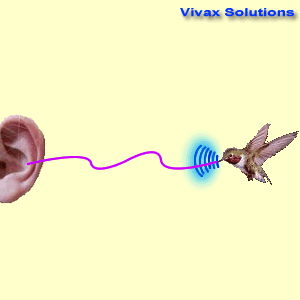Doppler Effect
Relative Motion
We all know what we see, when looking through
a window of a moving train: the trees and buildings seem to be going
backwards - a good way of being fooled by our own senses. In actual fact, these objects
remain where they are and just the perception causes all the confusion.
We see a similar distortion when looking at a
moving train - from another train. This time, if both train happen to be moving
in the same direction, one of them seems to be moving very slowly or at
rest. On the other hand, if they move in the opposite directions, they seem
to be moving apart much faster than they really do.
These observations clearly show the
importance of describing the motion of objects, with respect to where the observer is; we must talk about the position of
the observer, if the description of the motion is to make any sense.
When the motion is described along with where
the observer is, it is called the motion of the object relative to the
observer.
Therefore, the above examples should be
expressed as follows:
1) The motion of trees relative to a moving train
2) The motion of train A relative to train B
3) The motion of train B relative to train A
In short, every motion is relative; even at
the time of this article being read, you are moving at 67,000 mph - a
staggering speed, yet feeling nothing about it, because that is the speed of
rotation of earth around the sun.
So, when mentioning the speed of objects we
mean relative motion and the way the observation is made is equally
important.
E.g.1
The train A moves northwards at 30mph and the train B moves southwards at 10 mph. Find the velocity of train A relative to B.
A ↑30 B ↓10
Since we want the velocity of train A, relative to B, let's stop train B imaginatively. So, apply 10 mph in the opposite direction. Then apply the same to A in the same direction.
A ↑30 ↑10 B ↓10↑10
Now, B is at rest and A has a velocity of (30 + 10) = 40 mph.
A ↑40 B
That is the velocity of A, relative to B. A appears to be moving much faster than it really does.
E.g.2
The train A moves northwards at 30mph and the train B moves northwards at 10 mph as well. Find the velocity of train A relative to B.
A ↑30 B ↑10
Since we want the velocity of train A, relative to B, let's stop train B imaginatively. So, apply 10 mph in the opposite direction. Then apply the same to A in the same direction.
A ↑30 ↓10 B ↑10↓10
Now, B is at rest and A has a velocity of (30 - 10) = 20 mph.
A ↑20 B
That is the velocity of A, relative to B. A appears to be moving much slower than it really does.
Doppler Effect
When there is a relative motion between a sound source and the observer, the
apparent frequency is different from the real frequency of the sound source. This is called Doppler Effect.

When the humming bird approaches the man, the following take
place:
- Waves compress and wave length decreases
- The frequency increases
- The sound becomes high-pitched
- The facial gestures of the man show it has
not been music to his ears!
When the humming bird goes away from
the man, the following take place:
- Waves expand and wave length increases
- The frequency decreases
- The sound becomes low-pitched
- The facial gestures of the man show the
nightmare, however short-lived it was, is finally over
On both occasions, the man does not hear the actual frequency of
the sound of the bird; as there is a relative motion between the man and bird,
Doppler effect takes place; the apparent frequency is not the same as the true
frequency of the bird.
Further Examples:
1) When a police car approaches us, the frequency of siren goes high-pitched
2) Light that comes from distant galaxies approaches the red end of the spectrum - low frequency light
Please answer the following questions.
- A police care moves northwards at 30 mph and an ambulance moves in the same direction at the same speed. The policeman does not hear the siren of the ambulance becoming high-pitched. Explain.
- The frequency of sound of an ambulance siren is 2000 Hz. Its speed is 20 m/s. The speed of sound in air is 320 m/s. Find the frequency heard by a by-stander, when the ambulance approaches him
and going away from him.
- Discuss the frequencies of approaching light from a galaxy, in the event of a possible contraction of universe.